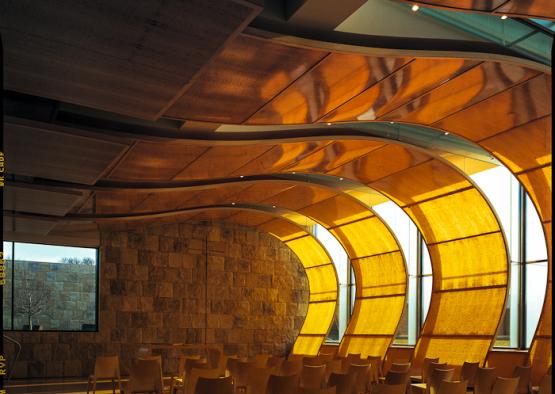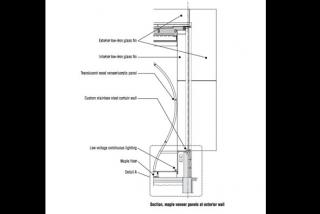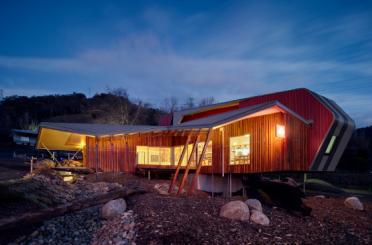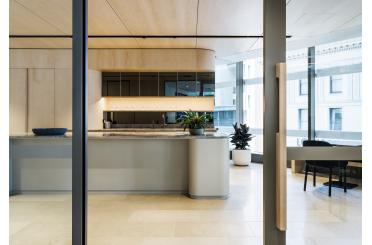
Overview
The United Theological Seminary is an ecumenical graduate and professional school of theology. They wanted a 500 square metre chapel building with a flexible 'sanctuary', accommodating seating in a variety of configurations, in addition to a vestibule and offices. The new structure also had to connect to an existing classroom building and architecturally acknowledge nearby modern buildings with brick and precast concrete exteriors.
As the focus of the building, the sanctuary had to evoke the eminence and presence of God, and address the religious lives of people of different denominations.
The design embodies a trinity of qualities, including intimacy, warmth and light; conveyed through a series of translucent, honey-coloured, quilted-grain maple panels that form 3.35 metre-wide curved floor-to-ceiling ribbons on one metre spacings.
To achieve the effect, a big-leaf maple log from the US Pacific Northwest was cut into 0.79 mm-thick veneer strips and laminated each side with non-reflective acrylic. Maple floors and quilted-grain maple ceiling panels that extend from the dropped ceiling of the processional hall into the sanctuary tie the processional and sanctuary together.
The maple panels filter and enrich the interior light, radiating a sense of warmth inside the sanctuary, while their curved profile wraps the visitor in a gentle embrace that creates an intimate environment for reflection and prayer.
Structure
The frame is steel, with cast-in-place concrete shear walls and 152 mm metal stud back-up wall, slab on grade and metal roof deck. The west curtain wall features a custom stainless steel frame with low-E clear glass and 25 mm-thick laminated low-iron glass fins; pre-cast concrete panels 450 mm x 450 mm x 60 mm with open joints.
Inside, the quilted grain big-leaf maple veneer (8 mm thick and 3.35 mm wide) is laminated each side with non-reflective acrylic and screwed to 38 mm x 68 mm hardwood frames, suspended at 4.87 m from cables. Suspended solid maple plywood panels project from the processional hall to the sanctuary and suspended from ceiling. Pre-cast concrete panels are as for the exterior, plaster is painted, maple floors, furniture and benches are finished with urethane.

Interior
Low-iron glass fins along the west curtain wall bracket the curving maple panels while screening and diffusing natural light. The fins also introduce a planar quality of weightlessness that is repeated in several other floating forms throughout the chapel building.
While the sanctuary is asymmetrical (the east side processional walkway slopes down 1.52 m), the space is balanced and contemplative. The maple liturgical furniture, chairs, hymnal storage and processional bench complement the curving translucent wood panels and the buff-coloured precast stone. The natural beauty of the wood contributes greatly to the sense of timelessness and spirituality.
The acrylic-laminated maple veneer panels create a 3-D effect. The veneer had to be sliced thinly and consistently to allow passage of natural light, which changes colour and creates an important contrast between the hard, rectilinear stone finish, and the soft backlit wood.
This project has been described as "a gem of material contrasts, modulated light and elegant proportions".



